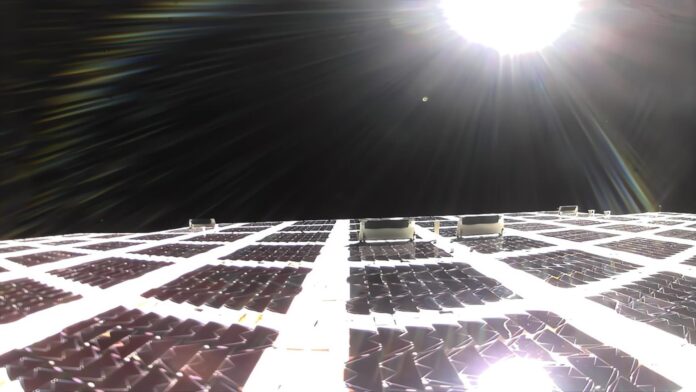A view from onboard the satellite, captured after deploying the 693-square foot array.
AST SpaceMobile
Satellite-to-smartphone connectivity venture AST SpaceMobile announced Monday that the wide antenna of its recently launched test satellite deployed successfully — a critical milestone in the company’s development of a global network to provide 5G broadband service.
The BlueWalker 3 satellite, launched on SpaceX’s Falcon 9 rocket in September, deployed its 693-square-foot antenna — which the company calls the largest-ever array deployed in low Earth orbit.
“Every person should have the right to access cellular broadband, regardless of where they live or work. Our goal is to close the connectivity gaps that negatively impact billions of lives around the world,” AST SpaceMobile Chairman and CEO Abel Avellan said in a statement.
A simulated view at the BlueWalker 3 satellite antenna deploying.
AST SpaceMobile
The company is among multiple contenders trying to create such a worldwide service, an untapped market that’s long been a dream for satellite communications.
AST’s network would consist of a constellation of 168 satellites, with the company saying it will reach global coverage once about 110 are in orbit. BlueWalker 3 represents AST’s second test satellite to date, and it plans to begin deploying its operational BlueBird satellites late next year.
The satellite company went public via a SPAC last year and has raised over $600 million to date. AST has racked up a number of mobile telecom partnerships for its service, including AT&T, Vodafone, Rakuten and more.
Chris Sambar, AT&T’s network president, said in a statement Monday that the company is “excited” AST has reached “this significant milestone.”
“Working with AST SpaceMobile, we believe there is a future opportunity to even further extend our network reach including to otherwise remote and off-grid locations,” Sambar said.
AST SpaceMobile stock jumped as much as 18% in premarket trading, but fell shortly after Monday’s open amid heavy trading volume – initially turning negative before swinging back positive. The company’s shares are up 11% from its previous close of $8.83 a share as of Friday’s close.


